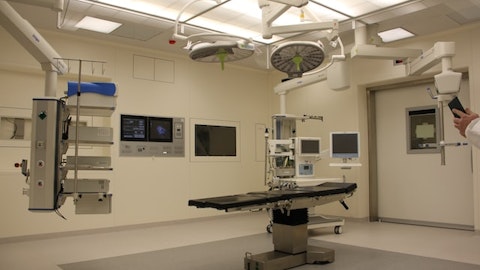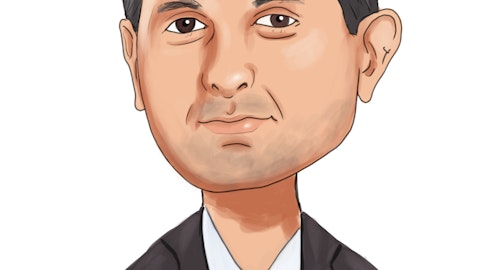And then now we’re back on page with most of those facilities. Some of them had moved on to other products, but for the most part, we’re able to get back on track with all those facilities. But then, there’s any additional time that it takes to stock and then start to ramp up. And then, we’re trying to regain some of the business from the surgeons and so forth, and, of course, the distributors that work with us as well. And retrain them, coach them back up on this particular product and then get it started again. So that’s where we see that and it’s kind of like that whole fourth quarter was kind of regain our footing, and then into this year start to sell and proactively approach new facilities and go beyond where we were. So, we kind of treaded water, if you will, and now we’re on the move forward and we feel confident in our approach and where we’re headed with that product.
It’s starting to move forward very nicely.
Operator: Your next question is from Michael Liu at IFCM.
Michael Liu: Hi, guys. Thanks for taking my questions. Congrats on the quarter. My first question, could you potentially clarify the sales force growth throughout the year? I think you disclosed last year that you ended the year at 39, and you’re at 39 now. And it sounded like you added a couple throughout the year, and it seems to be about flat. So, could you just maybe take us through the cadence of how many sales force reps you’ve had throughout the year and where the major changes have happened?
Zach Fleming: Yeah. I think the simple way to think of it is that three folks got reclassified and then four — roughly four got — [I know it was] (ph) four that got terminated in Q4. And then, so you had kind of reclassifications, promotions would be part of that, and then terminations.
Michael Liu: Okay. So broadly, it was…
Ron Nixon: Yes, Michael, the one thing that I think is the most noteworthy is that we accomplished 42% increase in revenue growth with the same number of beginning — at the beginning of 2023 or ending of 2022 and where we ended 2023. Our data analytics, as Zach mentioned earlier, are being well utilized. We’re seeing much better efficiency, and so we have a much better speed to profitability per rep. We also have a much better understanding of their potential and how to achieve that potential within each one of the areas that they’re selling in. So, I think the efficiency gains we’ve gotten there has given us great leverage on our sales force and then we’ll just continue to expand as needed into the marketplace.
Zach Fleming: We’re always making adjustments to the team — whenever we see all this data and analytics, we’re really trying to make adjustments that optimize the team. So, you’ll continue to see that, that’s not going to change. And we always want to increase efficiency where we can. And so that’s the second component of that, where we’re — like Ron said, we’re going to look at that data, we’re going to optimize location and we’re going to optimize the call points. And so, in doing that, that’s the kind of plus/minus, and we have to always let people go that maybe aren’t working out as well. So that just will continue to happen.
Michael Liu: Okay. Great. And on the Tissue Health Plus potential spin out or partnership, and I appreciate you can’t provide too many details yet, but I was curious if you could tell us what stage you are in the talks of doing that spin out. And my main question is when you do a transaction that one way or another gets Tissue Health Plus off your books, would that be a cash inflow to Sanara or a cash outflow for you, or would it not impact your cash?
Ron Nixon: Yeah. So, here’s how I would describe it, Michael. Our strategy, we’re very much big believers at Tissue Health Plus. No one has ever accomplished pulling the comprehensive strategy together the way that we’ve described it today to you. And our overarching goals are achieve funding for the strategy with partners that can actually help implement the strategy. As you saw that we’ve got the MSO network as part of what we do, that is not something that we would own, so that’s a partnership. And we have other needs out there related to the strategy that could be fulfilled with partners that have a better focus on certain areas of that. So, those are the types of value-added partners that we’re seeking. We want to have that accomplished in 2024.
We then want to begin to commercialize in 2025. And we assume there would be some sort of a pilot launch either probably sometime in the beginning of Q1 and then go full commercial. But the overall expectation is that this will be a cash flow generator long term. And whether or not that is accounted for under the equity method, where there’ll be distributions kicked out to Sanara or whether we still own the majority of it and it’s kicked out, one way or the other, we want to secure those partners that will help fund this strategy to completion and not be a significant drag on Sanara’s overall performance.
Michael Liu: Okay. Thanks. So, to clarify, you’re not looking at potential deal structures where, for example, Sanara would have to fund a JV along with a partner or something like that? You would definitely be…
Ron Nixon: Not in any significant way. We’ve already made lots of investment into that, and so that would be our contribution into the partnership.
Michael Liu: Okay. Thanks for taking my questions.
Ron Nixon: You bet.
Operator: [Operator Instructions] Your next question is from Chris Plahm with Tall Pines Capital.
Chris Plahm: Good morning, guys.
Ron Nixon: Good morning, Chris.
Zach Fleming: Good morning.


